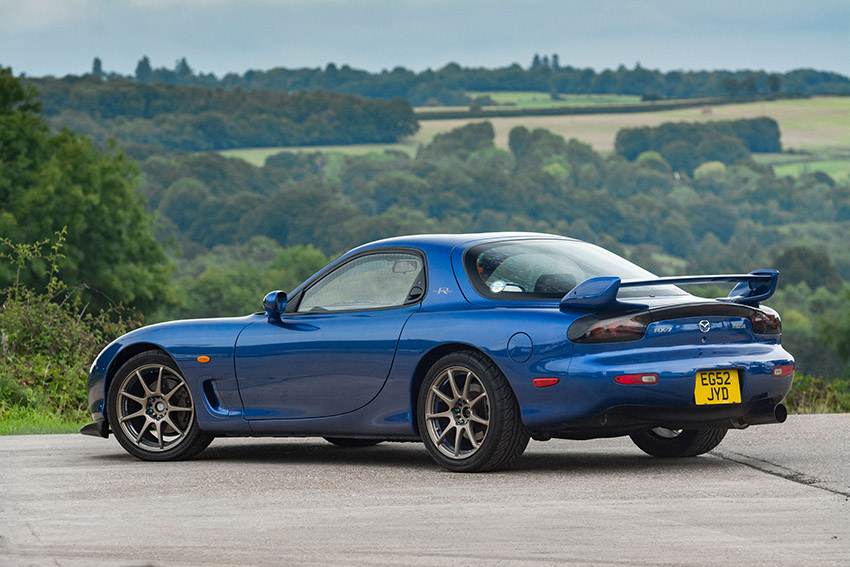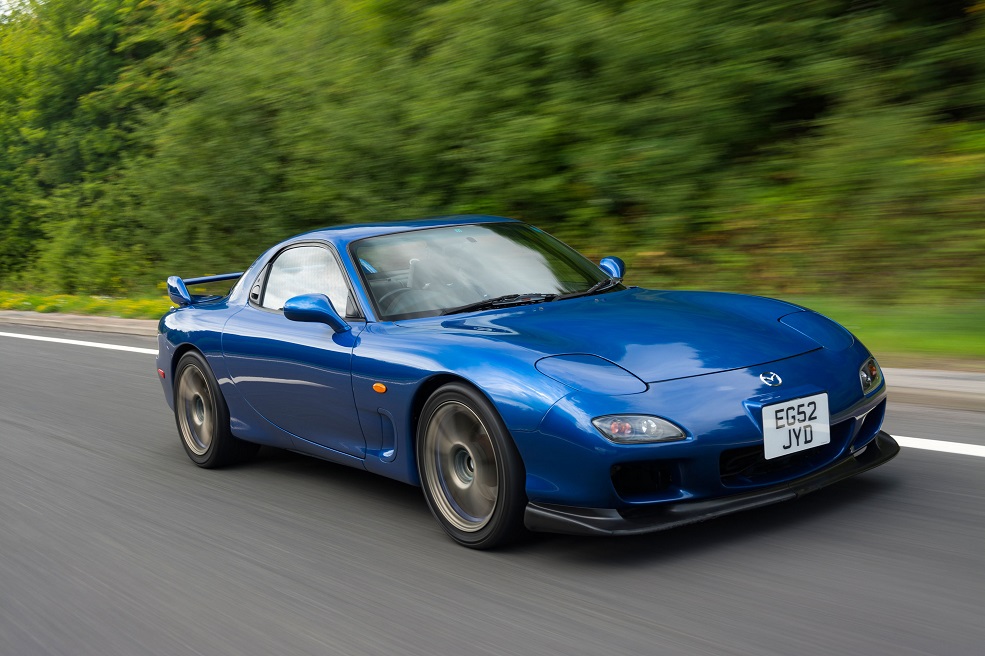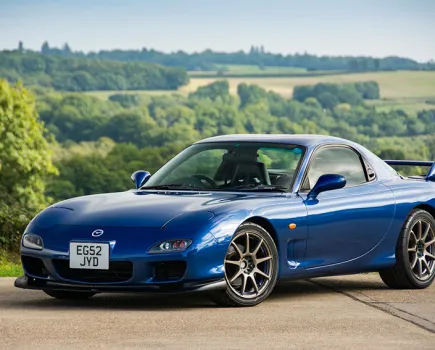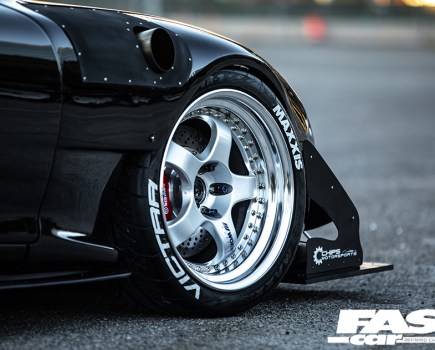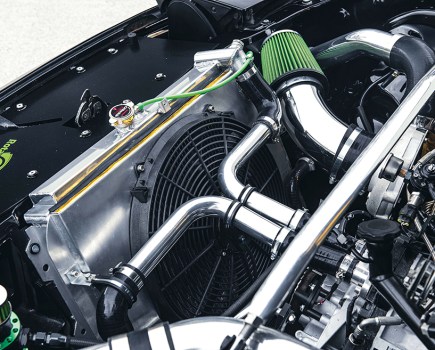Idolized and feared in equal measure due to its rotary engine, the Mazda RX-7 is one of the most unique sports cars to come out of Japan. Here’s our guide to all three generations.
Mazda wasn’t the first automaker to implement rotary engines in its cars. These days, though, it’s the one most closely associated with Wankel technology. Instead of pistons, rotary engines rely on rotors to combust an air fuel mixture. As there’s no reciprocating motion involved, the lack of engine vibration makes for a much smoother ride. But the advantages of rotary power don’t end there.
The headline is that you can get more power out of a smaller capacity engine. Naturally, those attributes lend themselves perfectly to a compact, lightweight sportscar. Which is why Mazda was eager to use rotary power in its most revered lineage of coupes. It’s not all sunshine and roses though. Fuel consumption in rotary engines is high. They also require a lot more maintenance due to their need to burn through oil. This has caught many unaware drivers out in the past, leaving the rotary engine with a harsh unreliability reputation.
Without further ado, here’s the full story behind the Mazda RX-7.
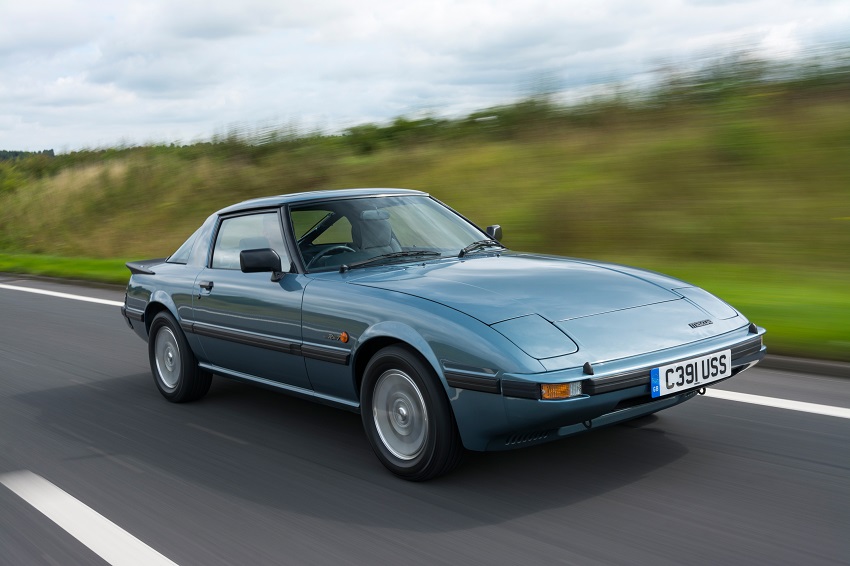
Mazda RX-7 (SA22/FB)
The tale begins in 1978. Mazda had been dabbling around with rotary-powered vehicles since the 1960s. After two decades of development, Kenichi Yamamoto (Mazda’s Head of R&D at the time) had come up with an iteration of the 12A rotary engine. This boasted improved fuel economy and more robust apex seals compared to Mazda’s earlier efforts.
With an engine now worthy, Mazda’s team of engineers were left with the rare task of designing the perfect car for it. It was pretty obvious from the outset that a lightweight, zippy two-door coupe would suit the 12A unit. Alas, the RX-7 was born.
The Series 1 RX-7 is born
Series 1 (or SA22 as its known by some) was on sale between 1978-1980. Its 1.1-liter engine contributed to a curb weight of less than 1100kg. Power in SA22 was good for a top speed of 115mph, and a 0-60mph time of just 9.5 seconds. In 1978, those sorts of figures from a car with an engine capacity that small were simply unheard of. Over in Japan, the small engine meant that customers could buy a sportscar while managing to swerve the tax. This is placed on everything with a 1.5-liter displacement or higher. Naturally, this played into Mazda’s hands nicely when it came to sales.
Another selling point of the SA22 was its handling. That featherweight mass, 50:50 weight distribution, an multi-link live axle suspension set-up, gave the car a playful, spirited nature that won over plenty of fans.
A Series 2 arrived in 1981 and heralded lightly revised styling. A five-speed manual gearbox became standard (although automatic options remained), and the car also sprouted a new, shorter gearstick. If customers opted for the GSL trim level, they’d benefit from a rear LSD and disc / rotor brakes all-round. Depending on where you are in the world, you might refer to these later Mk1 RX-7s as ‘FBs’.
The same is true for the Series 3, which debuted in 1984. A higher-end GSL specification was offered, as was a new engine referred to as the 13B (only for America). This upped capacity to 1.3 liters, and as a result, the RX-7’s power figures now peaked at 135hp. JDM-spec Series 3s were available with a turbocharged variant of the 12A. This ensured that the domestic market also had a more potent version of the car to enjoy.
Winning in motorsport
Motorsport prominence helps give a performance car its glowing reputation. Happily, the SA22/FB made its presence known on both the street and the circuit. The car won the 1980 & 1981 British Saloon Car Championship titles. It even took outright victory at the prestigious-yet-grueling 24 Hours of Spa. How’s that for proof of rotary reliability?
By most measures, the Mk1 RX-7 was a resounding success, and that’s proven in the numbers behind its forecourt popularity. Despite the unusual, Mazda managed to shift 470,000 Mk1 RX-7s. As a result, to this day it remains the all-time best-selling rotary-powered car.
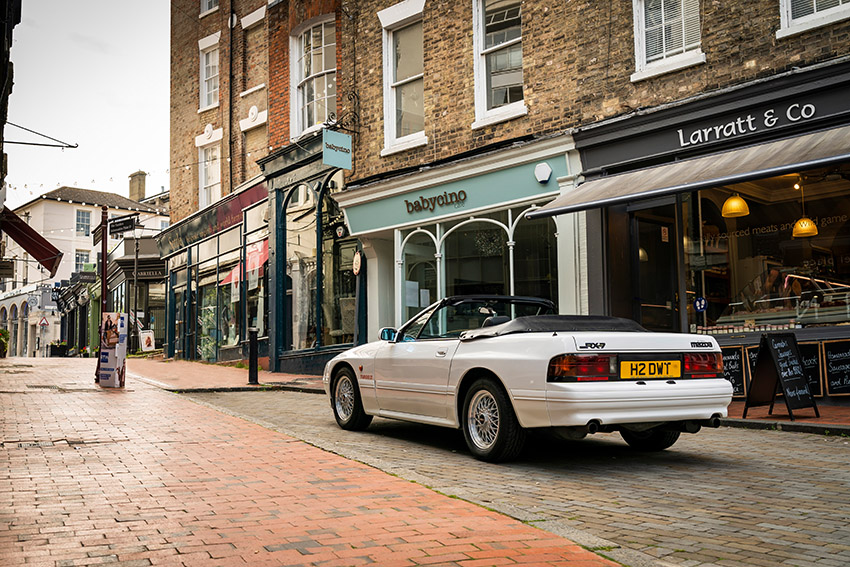
Mazda RX-7 (FC)
Given the positive reputation of the SA22/FB, you’d think Mazda would stick to a similar recipe when designing its successor. However, that wasn’t quite the case.
Sure, it retained rotary power and stuck to the two-door silhouette, but the Mk2 RX-7 (FC) wasn’t an all-out sportscar like the vehicle that came before it. Instead, the FC was a car built for long distance cruising, rather than tight and twisty touge runs.
The American Dream
The rationale behind this was the fact that Mazda had its sights set on appealing to America. After a stringent research program, it was decided that the eighties US customer base would prefer a softer, more powerful coupe.
As a result, the FC received a number of key changes to its underpinnings. The SA22 had its playful oversteer, but for the RX-7’s new touring design brief, Mazda wanted to introduce an extra element of stability to the way that the car drove. To do this, they swapped out the old live axle at the rear for an independent suspension set-up and introduced a bespoke bit of technology known as the Dynamic Tracking Suspension System, or DTSS. In practice, DTSS adjusts the toe angle of each wheel depending on the cornering force and direction that the car’s subjected to.
On top of that, the FC got a new damping system too. Referred to as Auto Adjusting Suspension (or AAS), this engineering solution would alter the dampers on the fly to comply best with the road surface underneath the car’s tires. Like the DTSS, this certainly improved the FC’s stability and ride comfort, but keen drivers became disappointed by the way that it numbed the feedback that the car could give you.

Rotary revolution
The handling of the reborn RX-7 was exactly how Mazda wanted it to be. Now it was time to focus on the second part of the car’s reinvention: power.
This time, the core 13B structure used in US-spec SA22s would become the standard engine offered across all international markets. However, the unit placed into the FC’s engine bay wasn’t identical to the ones found in the outgoing car.
Upon launch in 1985, the FC came fitted with a naturally aspirated 13B that featured new variable intake technology, but a year later in 1986, a turbocharged variant emerged. The newly fettled engine had already been uprated to around 150hp, but the addition of forced induction would elevate that figure to the 180hp-mark. By 1989, a revised twin-scroll turbo and enhanced compression ratio meant that the RX-7 FC was pushing 200hp: quite the improvement over the little 1.1-liter SA22.
Weight had also been kept down to a respectable 2600lbs / 1200kg or thereabouts, which when coupled with the car’s newfound power, gave the RX-7 a 0-60mph time of just 6.7 seconds. The top speed was now within touching distance of 150mph too. Performance figures like these were crucial to the FC capturing the premium feel that Mazda were striving for, while the introduction of a convertible version added a further luxury twist.
Mazda RX-7 FC Pros
- Characterful rotary engine
- Good handling & comfort
- Available as a convertible
Cons
- Rotary engine issues
- Cheap interior
- Potential for rust
Common problems
- Broken apex seals
- Faulty interior electrics
- Rear differential abuse
How to buy an FC RX-7
If you like the idea of refined rotary power with an emphasis on elegance, check out our Mazda RX-7 FC buyer’s guide before you go hunting around for one yourself. Likewise, more tuning-oriented drivers shouldn’t be put off by the FC’s calmer natural attitude. As this example proves, the second-gen RX-7 is a canvas which can still make for a fantastic project. Here’s our RX-7 FC tuning guide for more modifying advice.
Mazda RX-7 (FD)
Despite doing what they thought their target audience wanted, the second-gen FC RX-7 sold at roughly half the rate of the original car. For Mazda’s third instalment of the now-revered RX-7 nameplate, they decided to ditch the GT cruiser vibe in a big way.
Debuting in 1992, the Mk3 – or FD as its more commonly known – signaled a step back towards all-out agility and performance. In fact, it went further down that route than even the original SA22.
FD curves over boxy FC
It was the FC’s boxy Porsche 924-inspired styling made way for a refreshing curved design which really stood out amongst many of its more subdued rivals (think 300ZX, for example). The car’s sleeker stance matched what lay beneath the skin too. Although retaining the more advanced independent rear suspension system, the overall set-up of the car was a much more rewarding one than that of the FC. The ride was a little firmer, but not so firm that it was uncomfortable. Similarly, the steering had some extra weight to it. In these two alterations alone, the FD had become a far more communicative car than its predecessor.
With the RX-7’s handling now restored to perhaps what it should’ve been all along, further evolutions to the engine followed. Besides, with the onset of the nineties, the horsepower wars had kicked up a gear. The aforementioned 300ZX was churning out around 280hp from its V6, while the turbocharged variant of Toyota’s Mk4 Supra boasted 320hp in its Euro/American export guise. Against rivals like those, the engine used in the FC simply wasn’t going to cut it anymore.
Turbocharging wizardry
To get around this, Mazda introduced a new sequential twin-turbocharger, whereby the second turbo kicks in at 4000rpm for an extra splash of boost. Consequently, the FD’s peak power output raised to 236hp, or 250hp in Japan. Admittedly, this was still a fair distance away from the sort of power the Nissan and Toyota were offering, but against those cars the RX-7 had weight (or rather, a lack thereof) on its side. The Supra tipped the scales at 3307lbs /1500kg, as did the 300ZX. However, the FD RX-7 was around 550 lbs / 250kg lighter depending upon spec. As a result, the rotary-powered car reached 60mph quicker than the Nissan, and on a track felt like the more agile one of the bunch.
On paper then, there was plenty to like about the FD. Unfortunately, overambitious pricing put prospective buyers off. Upon release, the third-gen RX-7 positioned within Porsche territory, and that was a battle that it was never going to win. Consequently, Mazda shaved a big chunk off of its asking price a year or two down the line. By then the damage had already been done. The FD soldiered on in the UK up until 1998, but had bowed out from the rest of Europe long before then.
That didn’t result in the car’s demise though. Instead, Mazda reverted back to its roots, and transitioned the RX-7 into being a Japanese market-only special. As such, the top of the range Series 8 cars (built between 1998-2002) can only be imports if you live in the West.
Whichever individual age & trim level appeals to you the most though, the FD is perhaps the ultimate expression of the RX-7. In fact, we’d go a step further and say that it’s the ultimate expression of rotary power as a whole.
Mazda RX-7 FD Pros
- 50/50 weight balance means fantastic handling
- Phenomenal engine (when working)
- Timeless looks
Cons
- Constant TLC means expensive ownership
- Small cabin and small boot
- Can be fidgety at low speeds
Common problems
- Blown apex seals
- Saggy suspension
- Lack of oil maintenance
How to buy an FD RX-7
Enticed by the prospect? Then feel free to check out our FD buyer’s guide. There are also plenty of FD feature cars on the site to give you a bit of inspiration. Or, for an even closer look at the third-gen RX-7, check out our review of the ‘Bathurst R’ edition. Finally, for advice on modifying one, here’s our RX-7 FD tuning guide.
Love Japanese classics? Or are you in just in awe of the RX-7? Whatever your preference, we’ve got the show for you. We’re hosting Classic Japfest this October 6th at Goodwood Motor Circuit, don’t miss out on the action!

